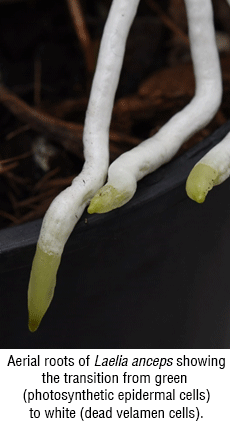In the video below we have taken the fluorescence images of the Laelia anceps velamin and reconstructed them in three dimensions.
<< BACK TO PROJECT LIST
Project: 316/2017
Title: Development of the velamen cell wall in roots of epiphytic and lithophytic orchids
Applicant: Dr David Collings
Institution: School of Environmental and Life Sciences, The University of Newcastle, Callaghan NSW
This project will investigate the development of the velamen, the multicellular layer of dead cells that covers the surface of orchid roots. Compared to terrestrial orchids where the velamen is thin, the velamen of epiphytic and lithophytic orchids that have aerial roots is typically much thicker, consistent with the velamen’s established role in water capture and retention. Velamen cells develop thickened, secondary cell walls before they undergo programmed cell death. These wall thickenings vary between different groups of orchids and have been studied as a taxonomic characteristic, and often form delicate networks of carefully-organised cellulose ridges.
As the process of wall thickening development of the thickenings remains poorly understood, this project will use a combination of confocal fluorescence microscopy, transmission electron microscopy and scanning electron microscopy to:
i) Characterise velamen development in selected epiphytic and lithophytic orchids, and,
ii) Determine the role played by microtubules in velamen formation.
The orchid root velamen provides a rare example of secondary cell wall formation in easily accessible plant studied cells. By comparison, the secondary cell walls of plant conducting tissues (the xylem) is more difficult to study. In these cell types, it is known that microtubules inside the cell determine the orientation of cellulose within the cell wall, but factors controlling microtubules arrangement are poorly understood. By understanding how the orchid velamen cell wall forms, this project will contribute to a more generalised understanding of secondary cell wall formation in all plant cells.


Research Outcomes
The carbohydrate cellulose, a polymer of the sugar glucose, is the most common polymer in the natural world as it is the primary component of the cell wall of all plants. Understanding the mechanisms through which plants structure their cell wall is of more than academic interest: the physical properties of the plant-derived materials such as the cotton that we wear, the paper that we write on, and the timber that we use for construction all depend on the organisation of the cellulose within the material. Despite several decades of research, scientists do not yet fully comprehend the processes through which cellulose within the cell wall is organised.
These specialised plant cell walls (cotton fibres, wood fibres, timber) are all examples of secondary cell walls. Such cell walls are only made by specific plant cells, and are much thicker and stronger than the cell walls that encompass the other cells found in the plant. The mechanisms that the plant uses to make these specialised secondary cell walls are thought to be similar to the processes than make general cell walls, but are not yet fully understood. Being able to understand secondary cell wall formation is, therefore, scientifically but also economically important.
In this project, the organisation of the secondary cell wall within the orchid velamen was investigated to determine whether it would be a suitable system in which to investigate the general properties of secondary cell wall formation. The orchid velamen is a multicellular epidermal layer found around orchid roots, and consists of dead cells that have patterned cell walls composed of aligned bundles of cellulose. These cell walls are, therefore, superficially similar to the specialised cell walls that form the majority of commercially important fibres. They do, however, have one specific difference and that it that they form at the surface of the plant, rather than in the plant’s interior, and are thus more readily available for experimentation.
The research in this project demonstrated that the organisation of the velamen is different in different orchid species. It also showed that as with other plant cell walls, the deposition of the cellulose within the cell wall is controlled by the organisation of the microtubule cytoskeleton within the plant cell.
Because of the suitability of orchids for tissue culture and genetic manipulation, and because the velamen cell walls are directly exposed to the surface of the root making them available for experimentation, this study concludes that the orchid velamen is a suitable model system for studying the organisation of the plant secondary cell wall. In particular, roots of the commonly-grown orchids Laelia anceps and Dendrobium sp. appear ideally suited to developing this research.
Lignified cell walls were stained with the dye basic fuchsin, and imaged in a cross section through the root of the orchid Dendrochilum gluamceum by confocal microscopy. The resulting optical series which covers a depth of about 30 μm was then converted into a 3D representation. In this species, the velamen layer is four cells thick, and these dead cells show lignified, secondary cell walls in a spiral pattern. Inside the velamen layer, the exodermis has a lignified outer wall which also shows tilsosomes. Understanding the formation of secondary cell walls in the orchid velamen may help researchers understand secondary cell wall formation in other systems, including the developing xylem. The scale bar equals 50 μm.
David Collings Papers published arising from this research:
Collings D, Aleamotu’a, M, McCurdy D. (2020) Phi Thickenings: Their history, Current Status and Role(2) in Mechanically Strengthening the Plant Root. Springer Nature Switzerland 2020 Progress in Botany https://doi.org/10.1007/124_2020_51
Idris N, Aleamotu’a M, McCurdy D, Collings D 2021 The Orchid Velamin: A Model System for Studying Patterned Secondary Cell Wall Development? Plants 2021, 10, 1358 https://doi.org/10.3390/plants10071358
